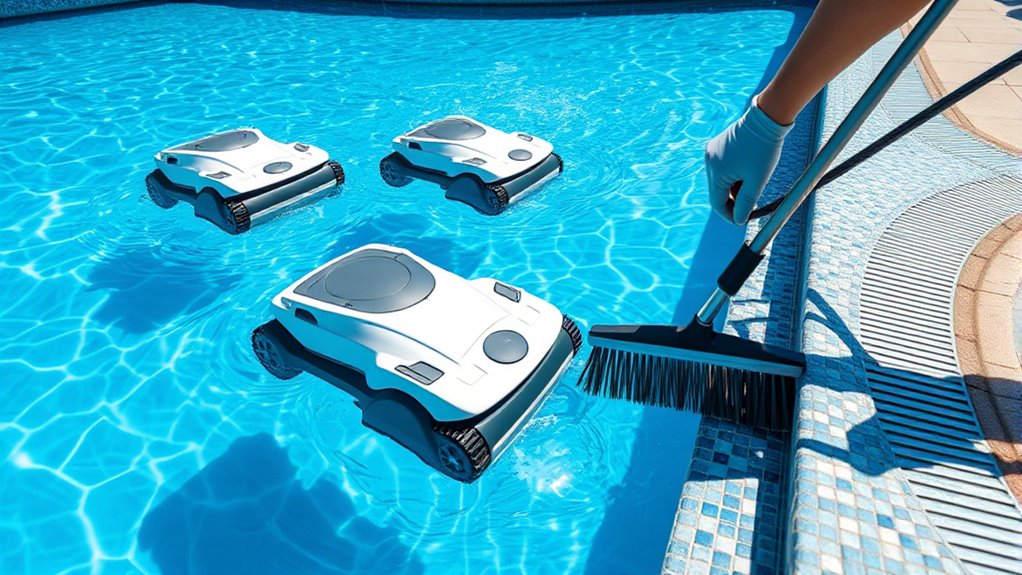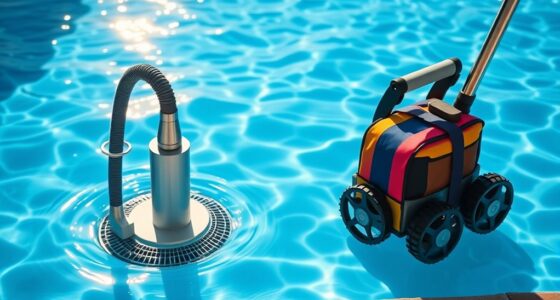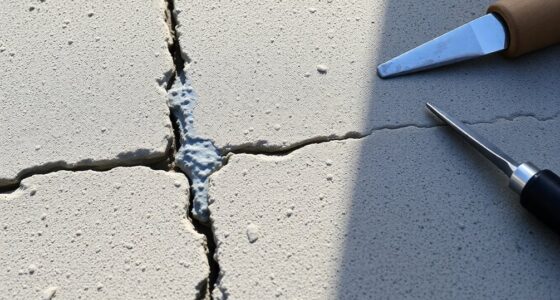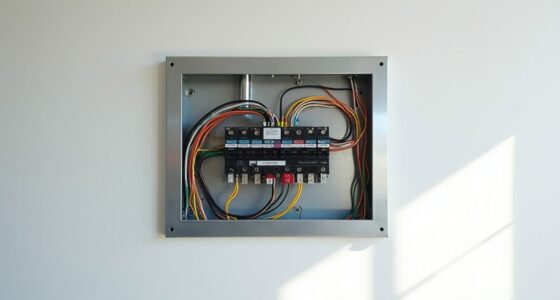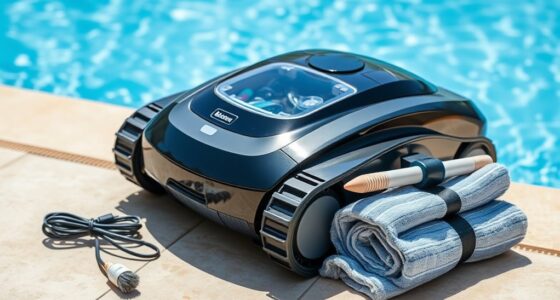Even with automatic cleaners, you still need to perform routine manual tasks like skimming the pool surface daily to remove floating debris, checking and maintaining water levels, and brushing the walls and tiles to prevent algae buildup. You should also regularly clean the filter system, inspect equipment for damage, and monitor chemical levels for safe water. Keeping up with these tasks helps guarantee your pool stays clean, healthy, and efficient—more tips to help you master pool maintenance await.
Key Takeaways
- Regularly remove large debris and leaves with manual skimming to prevent clogging and support automatic cleaner efficiency.
- Brush pool walls, tiles, and grout lines manually to prevent algae buildup and ensure thorough cleaning.
- Monitor and adjust chemical levels to maintain water balance and prevent algae growth, complementing automatic cleaning.
- Inspect and maintain pool equipment, including pumps and filters, to ensure the automatic cleaner operates smoothly.
- Backwash and replace filter media periodically to keep filtration system effective and water clear.
Regularly Skimming the Pool Surface
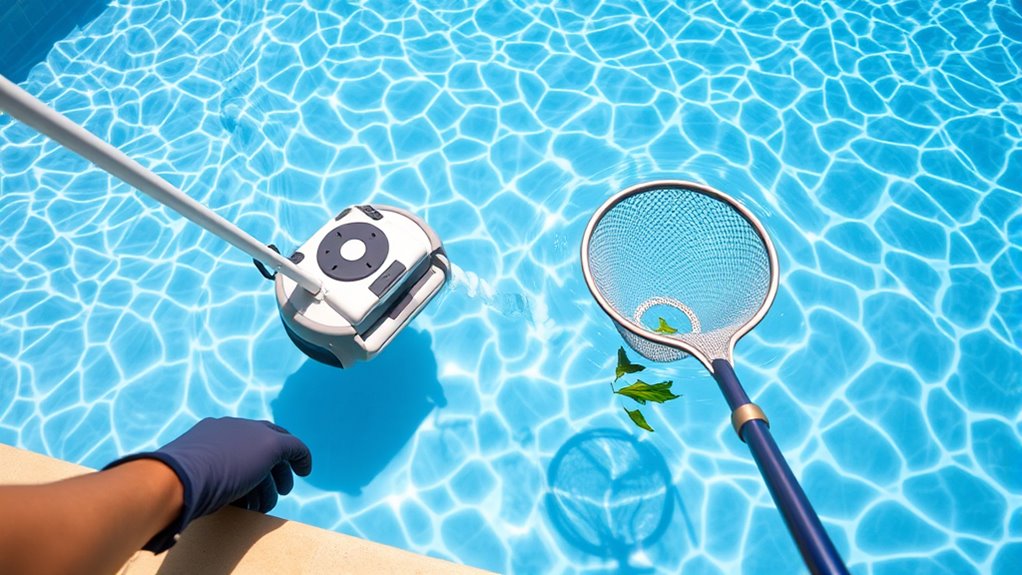
Regularly skimming the pool surface is an essential step in maintaining a clean and healthy swimming environment. By actively skimming debris, you prevent leaves, insects, and other floating particles from sinking and decomposing, which can cloud your water. Surface cleaning helps keep your pool looking inviting and reduces the workload on your automatic cleaner. Use a leaf net or a skimming tool to remove debris at least once a day, especially during windy days or after storms. This simple task prevents blockages and minimizes algae growth. Consistent surface skimming also ensures your automatic cleaner functions efficiently, as large debris can clog filters or hinder its movement. Staying on top of surface cleaning makes pool maintenance easier and extends the life of your equipment. Incorporating regular surface cleaning techniques can further enhance your pool’s overall hygiene and automatic cleaner efficiency. Additionally, verifying that your pool’s filtration system is functioning properly supports the overall cleanliness and helps prevent issues related to filter clogging and debris buildup. Regular maintenance of the filtration system is crucial for optimal water quality and equipment longevity, especially considering the importance of integration with automation tools for streamlined management.
Checking and Maintaining Water Levels

After you’ve cleared the surface of debris, it’s important to verify the water level is correct for ideal pool operation. Too low, and your automatic cleaner might struggle or get damaged; too high, and it could cause overflow. Regularly check the water level, especially after periods of hot weather or heavy use, when water evaporation and splash loss can lower the level. To maintain proper levels:
- Fill the pool with water to the skimmer opening
- Monitor water levels weekly during summer
- Address splash loss from swimmers promptly
- Use a hose with a spray nozzle for controlled topping off
- Consider adding a water leveler if evaporation is frequent
- Staying aware of water filtration systems can help automate water level checks and alert you to issues early. Incorporating automatic water level controls can further streamline maintenance and prevent problems before they arise. Understanding pool water chemistry is also crucial to maintaining optimal water quality and preventing issues like algae growth or corrosion.
Keeping the water at the right height ensures your automatic cleaner functions smoothly and your pool stays in top condition.
Cleaning the Pool Filter System
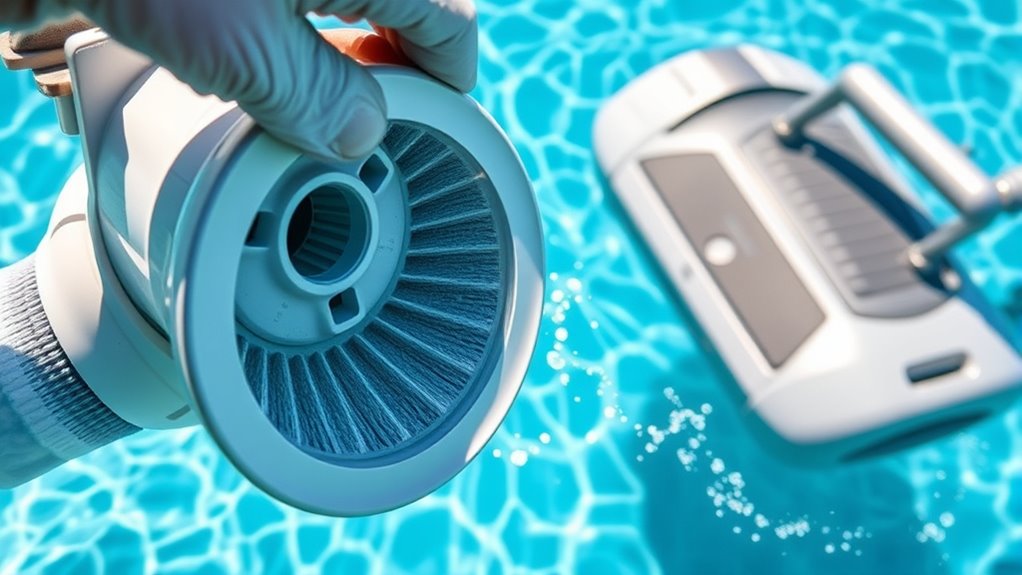
Maintaining your pool filter system is key to keeping your water clean. You should regularly inspect the filter, perform backwashing when necessary, and replace the filter media when it’s worn out. Staying on top of these tasks guarantees your automatic cleaner works efficiently and your pool stays crystal clear. Incorporating data-driven strategies can help you monitor your pool’s filtration performance more effectively.
Regular Filter Inspection
Since a clean filter is essential for your pool’s ideal performance, inspecting and cleaning the pool filter system should be a routine part of your maintenance. Regular filter inspection helps prevent clogs and keeps water flowing smoothly. Start by checking the skimmer basket; remove debris and rinse it out to improve skimming efficiency. Inspect drain covers for buildup or damage, ensuring proper water flow and safety. Look at the filter’s pressure gauge; a rise indicates it needs cleaning. Clean or replace filter media if necessary. Also, verify that all connections are secure and free of leaks. Regularly inspecting these components reduces strain on your automatic cleaner and keeps your pool crystal clear. Additionally, understanding filter maintenance can improve your knowledge of maintaining optimal equipment performance. To ensure thorough upkeep, consider consulting with a professional inspection service periodically to catch potential issues early. Regularly testing your filter system’s components can also help identify problems before they affect your pool’s clarity.
Backwashing Procedures Needed
Regular backwashing is essential to keep your pool’s filtration system functioning effectively. Knowing the right backwashing frequency prevents clogging and maintains water clarity. The backwash process involves reversing flow to remove debris from the filter media. Typically, you should backwash when the pressure gauge rises 8-10 psi above the normal operating pressure. During backwashing, turn off the pump, set the valve to backwash, and run the pump until the water runs clear, usually 2-3 minutes. Here’s a quick overview:
| Step | Action | Result |
|---|---|---|
| 1 | Turn off pump | Prevents damage |
| 2 | Set valve to backwash | Reverses flow |
| 3 | Run pump until clear water | Removes debris |
| 4 | Turn off pump | Prepares for rinse |
| 5 | Set valve to rinse | Clears remaining debris |
Stick to this process regularly to keep your filter in top shape. Regular maintenance can also help ensure your appliance systems operate efficiently and extend their lifespan. Additionally, understanding the filter media type can help optimize the backwashing process for better results. Properly maintained filters are crucial for indoor air quality, which is important for a healthy environment around your pool area. Regularly inspecting and replacing worn filter media also helps improve overall system performance and water quality. Performing routine inspections on your filter system ensures early detection of issues, saving time and repair costs.
Replacement of Filter Media
When the filter media becomes clogged or worn out, replacing it is essential to guarantee your pool’s filtration system works efficiently. Regular replacement maintenance ensures clear water and prevents strain on your pump. You should inspect your filter media regularly for signs of wear or debris buildup. If you notice reduced flow or cloudy water, it’s time for a change. Keep these tips in mind:
- Use the correct filter media type for your system
- Follow manufacturer instructions for replacement
- Rinse the new media thoroughly before installation
- Schedule replacements at least once a season
- Keep spare filter media on hand for quick swaps
Performing timely filter media replacement maintenance keeps your pool water clean and your system running smoothly. Don’t neglect this task to avoid costly repairs later. Additionally, leveraging automation’s role in business intelligence can help track and schedule maintenance tasks efficiently.
Brushing Pool Walls and Tiles

Brushing pool walls and tiles is essential for preventing algae buildup and removing stubborn dirt that automatic cleaners might miss. Regular brushing helps keep algae prevention in check by disrupting its growth and removing microscopic debris. It also aids in stain removal, especially in areas where mineral deposits or algae tend to settle. Use a stiff-bristled brush for tiles and a softer brush for painted or vinyl surfaces to avoid damage. Focus on corners, grout lines, and the waterline, where grime tends to accumulate. Consistent brushing not only keeps your pool looking clean but also reduces the strain on your automatic cleaner, making its work more effective. Incorporating remote hackathons into your routine can also inspire new ideas for maintaining your pool equipment and systems, ensuring optimal performance and longevity. Being aware of Louisiana alimony laws can also help you plan financially after pool maintenance routines, especially if a divorce has impacted your budget.
Monitoring Chemical Balance
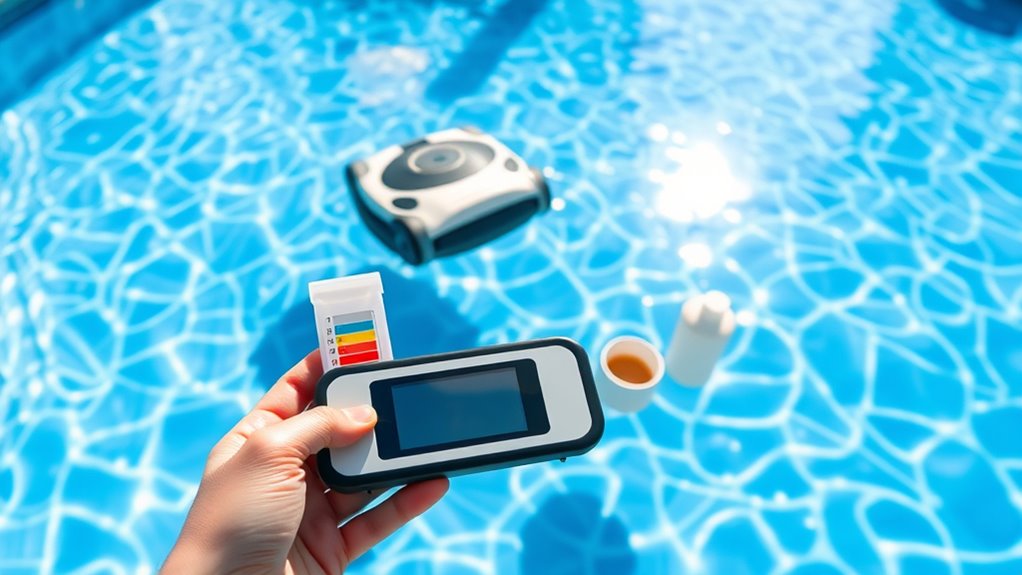
Monitoring your pool’s chemical balance is essential for maintaining safe and healthy water. Regular chemical testing helps you keep track of pH levels, chlorine, and alkalinity, preventing issues like algae growth or skin irritation. To guarantee proper balance, you’ll need to adjust pH when it’s too high or low, which is vital for effective disinfecting. Use test kits or digital testers for accurate readings. Keep an eye on these key points:
- Conduct chemical testing at least once a week
- Adjust pH to stay between 7.2 and 7.6
- Maintain proper chlorine levels
- Monitor alkalinity and calcium hardness
- Record test results for consistent maintenance
- Incorporate automatic monitoring devices to help track and maintain chemical levels more precisely
Staying vigilant with chemical testing and pH adjustment keeps your pool safe, clear, and inviting.
Inspecting and Managing Pool Equipment
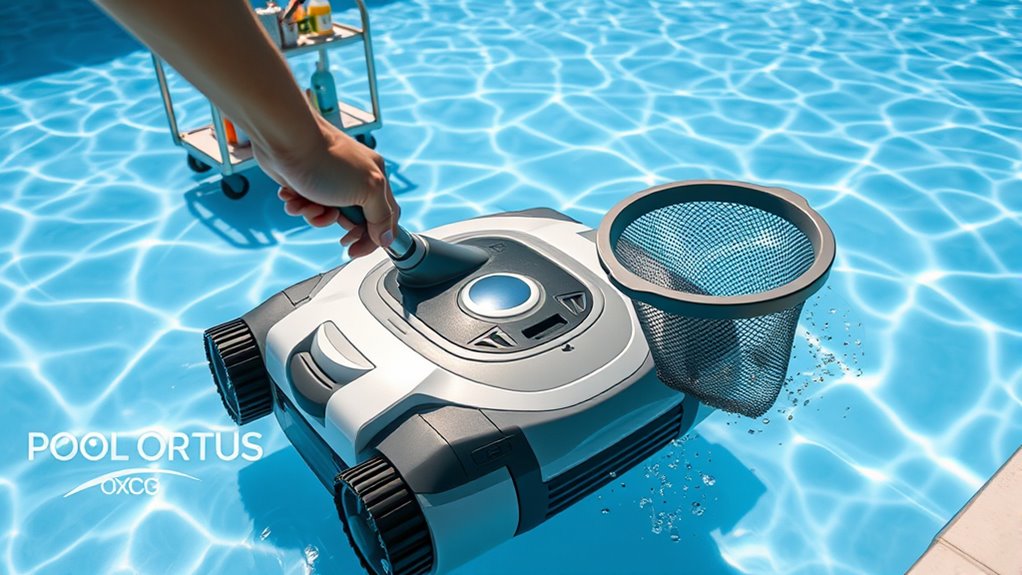
Regularly inspecting your pool equipment guarantees everything runs smoothly and efficiently. You should routinely check your pump and filter for clogs or leaks and listen for unusual noises. Catching mechanical issues early helps prevent costly repairs and keeps your automatic cleaner working properly. Additionally, staying aware of automation technologies can help you understand how modern systems are improving maintenance processes.
Equipment Inspection Routines
To guarantee your automatic pool cleaner operates effectively, it’s essential to routinely inspect your pool equipment. Regular checks help maintain proper pool chemistry and prevent algae buildup. Start by examining the skimmer and pump baskets for debris, ensuring unobstructed flow. Verify that your chlorine levels are balanced to support algae prevention. Inspect hoses and connections for leaks or cracks, replacing damaged parts promptly. Check the pool’s water level, as low levels can strain equipment. Also, review the condition of the automatic cleaner’s tracks or brushes for wear. Additionally, clean the filters regularly to keep your pool’s circulation ideal. These simple routines ensure your equipment functions smoothly, extending its lifespan and keeping your pool clear, safe, and inviting. Recognizing the value of consistent maintenance can also prevent costly repairs and ensure long-term enjoyment of your pool.
Pump and Filter Checks
Ensuring your pump and filter are functioning properly is key to maintaining a clean and healthy pool. Regular pump maintenance helps prevent issues like low flow or strange noises, which could indicate a problem. Check the pump basket and skimmer regularly, removing debris that could hinder water circulation. For the filter, perform routine troubleshooting if you notice cloudy water or decreased flow. Backwash sand or DE filters as needed, and clean cartridge filters according to the manufacturer’s instructions. Keep an eye on pressure gauges; a rise can signal that your filter needs cleaning. Proper pump and filter checks ensure your automatic cleaner works efficiently and reduces the risk of equipment failure, keeping your pool sparkling and safe for swim enthusiasts. Additionally, understanding celebrity lifestyle insights can offer inspiration for designing your own outdoor retreat.
Detecting Mechanical Issues
Detecting mechanical issues early is essential for keeping your pool equipment operating smoothly. Regular inspections help prevent costly repairs and ensure everything runs efficiently. Start by checking your drainage system for clogs or leaks, which can cause water imbalance. Examine the pool liner for tears or signs of wear that could impact circulation. Listen for unusual noises from pumps or filters, indicating potential problems. Inspect the automatic cleaner’s brushes and hoses for damage or blockages. Also, monitor the pressure gauges; abnormal readings often signal underlying issues. Addressing these small problems promptly keeps your pool functioning properly and extends the lifespan of your equipment, saving you time and money in the long run.
Removing Large Debris Manually
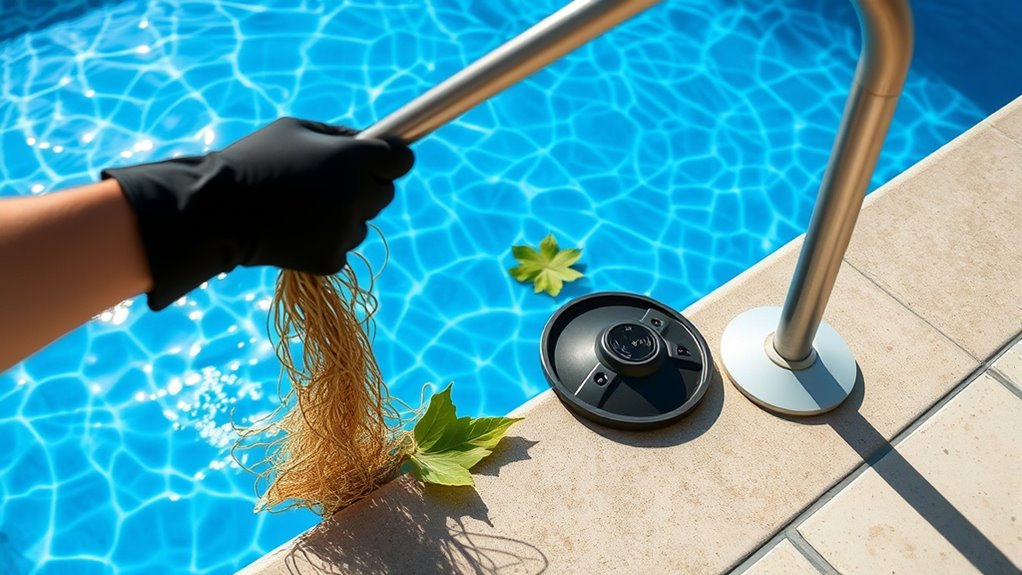
When large debris such as leaves, twigs, or insects accumulate in your pool, removing them manually is a straightforward but essential task. You’ll want to regularly perform leaf removal to prevent clogging and water quality issues. Grab a skimmer net and carefully scoop out the large debris floating on the surface or settled at the bottom. This quick effort keeps your automatic cleaner running smoothly and maintains clear water.
| Keep Your Pool Clear | Enjoy a Sparkling Pool |
|---|---|
| Remove large debris | Swim without worries |
| Prevent clogging | Avoid costly repairs |
| Maintain water quality | Celebrate clean swims |
| Reduce chemical use | Feel confident in your pool |
| Save time in the long run | Relax with peace of mind |
Winterizing and Seasonal Care
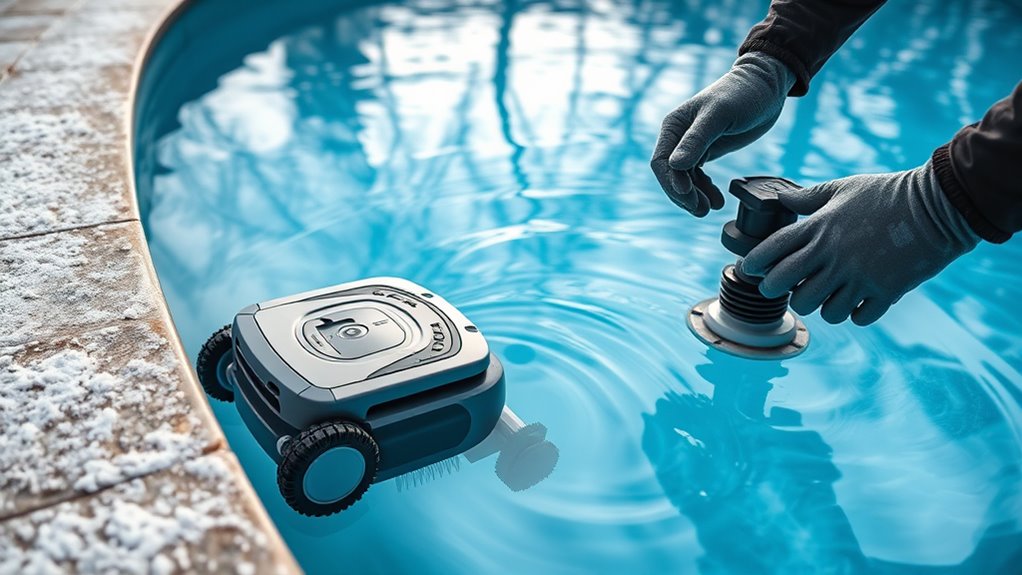
As winter approaches, it’s essential to prepare your pool to withstand the colder months and prevent damage. Proper winterizing involves several key steps. First, balance your water chemistry with the right chemical treatment to prevent algae and corrosion. Then, clean your pool thoroughly to remove dirt and debris. Cover your pool with a durable winter cover to keep out leaves and pests. Drain pump and filter systems, and add antifreeze if necessary. Regularly inspect your cover for tears or water accumulation. Additionally, remove any ladder or accessories that could be damaged by ice. By following these steps, you’ll protect your pool and simplify opening it in the spring.
- Balance water chemistry with chemical treatment
- Clean and remove debris before covering
- Install a sturdy winter cover
- Drain and winterize equipment
- Inspect cover periodically
Frequently Asked Questions
How Often Should I Replace My Automatic Pool Cleaner?
You might wonder about the replacement schedule for your automatic pool cleaner. Typically, a cleaner’s lifespan is about 3 to 5 years, depending on usage and maintenance. Keep an eye on its performance; if it becomes less effective despite cleaning and repairs, it’s time for a substitute. Regularly inspecting parts and following manufacturer guidelines can help extend its life and ensure your pool stays clean.
Can Automatic Cleaners Damage Pool Surfaces or Equipment?
Did you know that improper use of automatic cleaners can cause surface damage in about 15% of pools? You might worry about surface damage or equipment wear, but most issues come from aggressive cleaning or incorrect settings. To prevent this, follow manufacturer instructions carefully, avoid high-pressure settings, and regularly inspect your equipment. With proper use, automatic cleaners won’t harm your pool surfaces or equipment, keeping your pool in top shape.
What Are Common Signs My Cleaner Isn’t Functioning Properly?
If your automatic cleaner isn’t working properly, look for common signs like filter clogging, which can reduce suction and cleaning efficiency. You might also notice abnormal noises, such as grinding or rattling sounds, indicating a problem with the motor or brushes. These issues suggest maintenance is needed, like cleaning or replacing filters, or checking for obstructions to guarantee your cleaner works effectively and extends its lifespan.
Are There Specific Maintenance Tips for Different Types of Pool Cleaners?
Imagine your pool gleaming under the sun, and you realize proper maintenance depends on your cleaner’s type. For different types of brushes, like rubber or nylon, choose compatible cleaners to avoid damage. Regularly check cleaner compatibility with your pool’s surface, and adjust cleaning routines accordingly. Keep an eye on wear and tear, and follow manufacturer tips for maintenance, ensuring your automatic cleaner runs smoothly and keeps your pool pristine.
How Do Manual Tasks Complement the Efficiency of Automatic Pool Cleaners?
Manual tasks complement automatic pool cleaners by ensuring your equipment stays in top shape and operates efficiently. You should perform regular manual labor like brushing walls and skimming debris, which automatic cleaners might miss. Additionally, routine equipment checks help identify issues early, preventing breakdowns and maintaining ideal performance. Combining manual tasks with your automatic cleaner’s efforts keeps your pool cleaner, clearer, and ready to enjoy whenever you want.
Conclusion
While automatic cleaners handle much of the work, don’t forget the manual tasks that keep your pool sparkling. Think of these chores as the backbone of good maintenance, ensuring everything runs smoothly beneath the surface. By staying proactive—skimming, checking water levels, and inspecting equipment—you’re the captain steering your pool clear of trouble. Keep up with these essential tasks, and your pool will be a shimmering oasis, shining brighter than a diamond in the sun.
